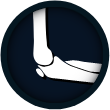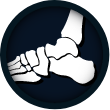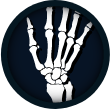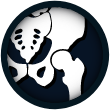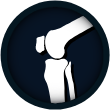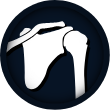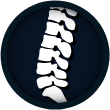Spine
The spine is made up of small bones known as vertebrae that are stacked on top of one another, extending from the base of your skull to your buttocks. Muscles, ligaments, nerves, and intervertebral disks are all part of your spine as well.
Your spine consists of three segments, which form three natural curves when viewed from the side. The “c-shaped” curves of the neck (cervical spine) and lower back (lumbar spine) are called lordosis. The “reverse c-shaped” curve of the chest (thoracic spine) is called kyphosis.
These curves are important for balance and they help us to stand upright. It is important that these curves stay in shape, because if any one of the curves becomes too large or small, there will be problems with our standing positions and posture.
When abnormal curvatures of the spine occur (known as spinal deformity), this can result in conditions such as kyphosis of the thoracic spine (“hunchback”), lordosis of the lumbar spine (“swayback”), and “flatback syndrome,” a condition in which there is too little curvature of the spine.
Back Sprain due to a Sudden Twisting of the Back
WHAT HAPPENS WHEN I SUDDENLY TWIST MY BACK?
The back is a complex structure made up of bone and muscle, supported by cartilage, tendons and ligaments, and fed by a network of blood vessels and nerves.
When a sudden twisting motion occurs, the muscles, tendons and ligaments can experience a sudden stretch that is beyond their normal range of motion and end up tearing, resulting in a sprain in the back. Back sprains are a very common injury.
WHAT ARE THE SYMPTOMS OF A BACK SPRAIN?
Symptoms of a back sprain include:
- Pain that worsens with movement
- Muscle cramping or spasms
- Decreased function and range of motion such as while walking, standing and bending
WHAT IS THE DIAGNOSIS OF A BACK SPRAIN?
A history of the injury and a physical examination of the back will be conducted by the Doctor. Imaging tests will be taken, such as a x-ray to rule out other conditions such as fractured bones or a herniated disc as a cause of the pain.
WHAT ARE THE TREATMENT OPTIONS FOR A BACK SPRAIN?
Patients who suffer from a back sprain can recover with nonsurgical treatments. This includes:
- The use of ice and compression packs to help reduce pain and swelling
- Over-the-counter pain relief medications such as acetaminophen and nonsteroidal anti-inflammatory drugs such as ibuprofen to help reduce pain and swelling
- Back supports such as a brace to support your back during healing
- Physiotherapy to regain muscle strength and restore mobility





